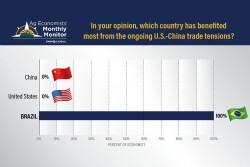Soybean News
The latest soybean commodity market news and insights for soybean producers and agribusiness.
Click here to view today’s soybean prices.
As farmers look ahead to 2026, grain markets are sending mixed signals based on record corn exports, large supplies, federal payments and ongoing China trade uncertainty.
The U.S. Climate Prediction Center forecasts the weather pattern to persist for the next month or two, which is ideal for soybean reproductive stages, but the transition might impact the tail-end of the region’s growing season.
Trade did not expect a change in corn stocks, but USDA surprised with a big increase to exports from already record levels.
Treasury Secretary Scott Bessent says China is making progress on its commitment to buy U.S. soybeans, hitting the “correct cadence,” with purchases expected to wrap by February 2026 — underscoring ongoing trade commitments and support for farmers.
Wheat acres are expected to decline, and little change is anticipated for cotton acres after a drop in 2025.
Going into the final weeks of the year, many growers across the country are shouldering significant financial strain from land rent payments, rising input costs, and efforts to stay in business and viable until commodity prices improve.
Farmers who suffered losses from natural disasters that occurred in calendar years 2023 and 2024 can sign up for the aid. It is also available to farmers participating in the On-Farm Storage Loss Program and the Milk Loss Program.
After three straight years of having a May-planted crop that outperformed corn planted only a few weeks earlier, some Illinois farmers are ready to throw in the towel on planting corn before the calendar turns to May.
Arlan Suderman says the U.S. is strengthening ties with Argentina to counter China’s growing influence — a global strategy that’s leaving many U.S. farmers and ranchers feeling sidelined.
Beijing’s refusal to buy American and its pivot to Brazil could be less about economics and more to do with politics. “It’s a calculated decision about control and national leverage, not about getting the cheapest beans,” says one ag economist.










